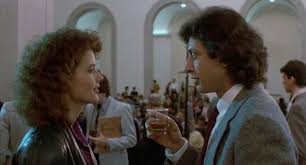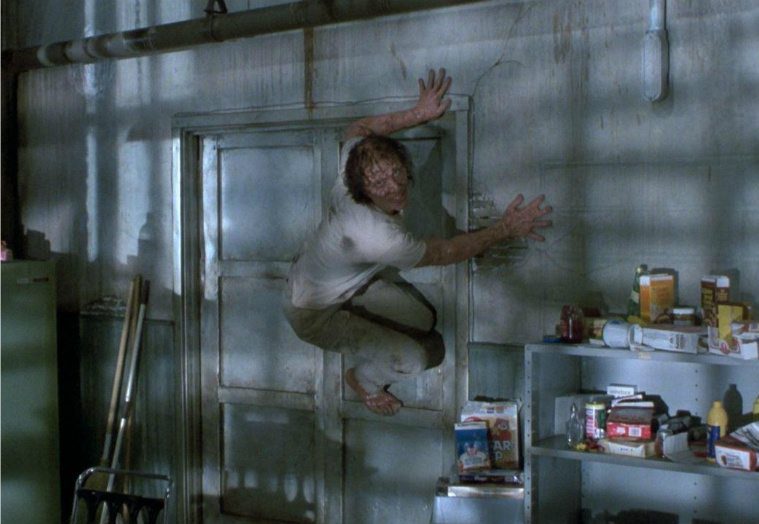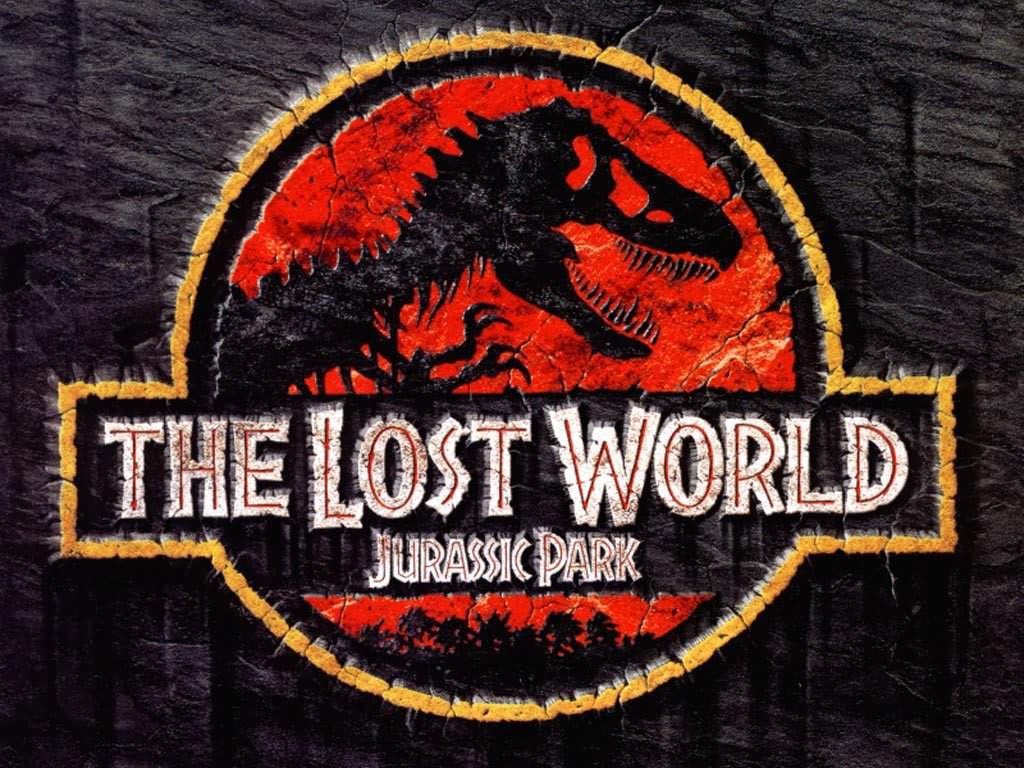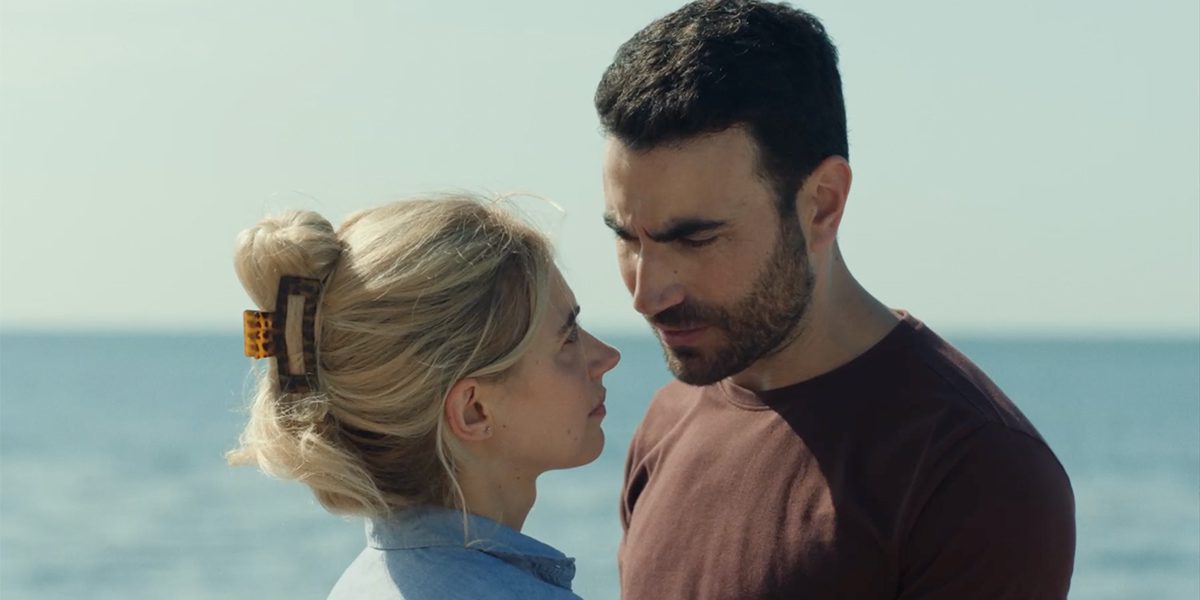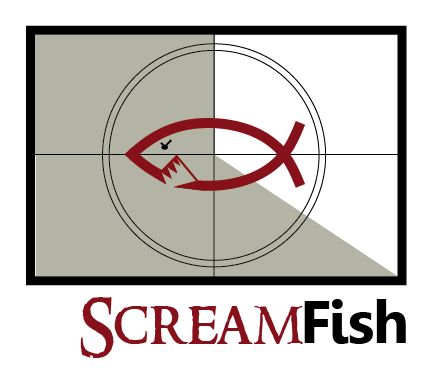 What a difference thirty years can make.
What a difference thirty years can make.
Case in point: back in 1958 when David Hedison portrayed the title role in The Fly, he ended up buzzing around as an itsy bitsy insect with his still quite human (yet miniaturized) head and arm intact. Shocking for the time, perhaps, but kinda fun.
Fast forward to 1986 and Jeff Goldblum?s interpretation of the character in the David Cronenberg re-make. Yep. There he was, breaking down the enzymes in his food by vomiting on it prior to sucking it all back up again?a necessary process to obtain nutrition amongst flies. Shocking for the time and just plain gross.
It is in fact, not so well documented, that viewing of the Cronenberg version became a challenge, nay, a rite of passage amongst rural Virginia adolescent males (or at least one middle school’s worth).? Making it through that scene (thankfully, you don?t get to watch the consumption of said meal) and a half-dozen equally-nauseating others was tantamount to earning a merit badge in Badassery.
You had not truly lived, according to the court of three-chest-haired locker room opinion, until you’d experienced the last half of the film’s smorgasbord of gore. And just like Shoney’s breakfast buffet, there was something for everyone: compound fractures, facial skin sloughing, human-baby-sized maggot delivery (think ONGYN operating room, not Domino’s). And if you were really tough, you kept it all down and went back for seconds (again, like Shoney’s).
The mere viewing itself became the stuff of urban legends (did you hear about Kevin XYZ? I heard he was so freaked out by it he can’t ever close his eyes again!); reports of tallied viewings whispered in the same reverential tones reserved for Canon.
It was a freakshow, a spectacle.
Fast forward three decades and now, one of those formerly gore-hungry teens sees a lot more in The Fly. Sure, the gross-out scenes are atull as gruesome as ever, but layered underneath, there’s psychological insight into the seclusion of paranoia and social warnings on the dangers of familiarity (and more so, on the perception of familiarity). There’s depth and pathos and symbolism.
There’s meat there, meat that even poor, non-chewing Seth Brundle could enjoy.
What a difference thirty years makes.
David Cronenberg could be your CPA.
That would be a likely misconception if you were to profile him strictly based upon his looks. A flop of well-coiffed hair, stoutly-rimmed glasses, conservative dress shirt, tie and smart, sharp suit coat?he fits the CPA mold perfectly. Heck he could even be a lawyer or a doctor.
But that?s not nearly as fun as having Geena Davis give birth to a bouncing baby maggot (incidentally, he played the gynecologist in that scene from his 1986 hit, The Fly. See? Told you he could be a doctor).
Cronenberg has directed over twenty-five films, and much like the man himself, his pictures aren?t always as cut-and-dry as they would first appear to be. Case in point: the aforementioned, The Fly.
Upon first glance, it could be written off as a gore fest meant to exploit the much less graphic 1958 original directed by Kurt Neumann (who also helped Tarzan conquer The Big Screen in the ’40s and ’50s). But Cronenberg, ever the master of off-balance horror, jabs with just enough splatter to keep you at bay before thudding you in the teeth with a story and characters that will leave you reeling for hours afterward.
There is no build up, no time to prepare. We are simply thrust?like uncomfortable protagonist, Seth Brundle (Jeff Goldblum)?into the middle of a cocktail party. And like Brundle, we feel awkward and out of place, jumping right in with no backstory or history. We don?t really know why we?re there and we don?t recognize a soul. Thank goodness for Veronica Quaife (Geena Davis), a magazine reporter who saunters up and strikes up a conversation. ?Turns out the gathering is a press junket hosted by the company that funds Brundle?s work. Brundle woos her back to his place,convincing her to have a look at his latest project which he guarantees will “change the world.”
Sitting there, smack dab in the middle of Brundle’s swinging warehouse/bachelor pad are two hulking metal domes that he has dubbed “telepods”. He gives Veronica the two-cent demonstration, teleporting one of her stockings from one of the pods to the other. Inanimate objects present no problem for teleportation, he explains, but he confesses that he cannot pull off the same stunt with living creatures. Veronica is nonetheless impressed, revealing that she is in fact, intends to run with the story. Upset, Brundle insists their interaction was off the record, demanding that she not publish anything until his research is complete. He promises to give her the exclusive when the time is right.
Impatient, Veronica takes the story to her editor (a former suitor), Stathis Borans (John Getz), who promptly dismisses it as charlantry. Undeterred, Veronica returns to Brundle, and begins to document his work over the coming weeks.
He attempts to teleport a baboon, with horrible, explosive results. Brundle goes back to the drawing board and soon romance blooms between with Veronica. After a moment of intimacy, Brundle is taken by inspiration. He suddenly realizes he needs to reprogram the telepods so that they will be able to process the data necessary to teleport living things. As he is working on the machines, Veronica leaves to pick up dinner. She runs into Borans, who?s changed his mind about the Brundle story and wants to run it.
Soon after, Brundle successfully teleports another baboon who comes out of the second pod completely unharmed. Brundle wants to celebrate by staying in for a romantic evening with Veronica, but she takes off. Unbeknownst to him, she secretly meets with Borans, who is jealous of Brundle and threatening to publish a story on the project. All the while, Brundle sits at home getting toasty drunk as he imagines Veronica trysting with Borans. Jealous and angry, he decides to play guinea pig to see if his technology will work with a human subject. He hops into one of the pods. And so does an undetected housefly.
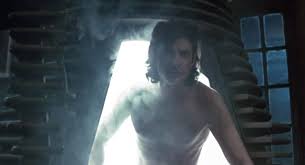
Hilarity ensues.
Psych.
Actually a slow descent into terror ensues, because that?s what Cronenberg does best.
Brundle pops out of the other pod, trumping time and space, apparently fit as a fiddle. In fact, he appears to come out even better than before, almost instantly able to lay down a high bar routine that would make Mary Lou Retton jealous. He experiences a moment of self-actualization, claiming to finally have emerged from that iron chrysalis as the man he was meant to be. He begs the now-returned Veronica to duplicate his feat but she refuses.
The next day, she notices an odd tuft of rigid hairs growing from a scratch on his back. She clips them, though a few days later they will grow back even denser.
Brundle?s metabolism begins to take off at hyperspeed, and soon he?s devouring donuts and PixieStix at a diabetic-coma-pace. His sexual appetite follows and he quickly shuns Veronica when she can?t match his libido. During a spastic night on the town, Brundle arm wrestles a good ol? boy for a date with his girlfriend and snaps the redneck?s wrist like a twig. He leaves with the girl, and after a long night, tries to convince her to use the telepod. As she refuses, Veronica walks in.
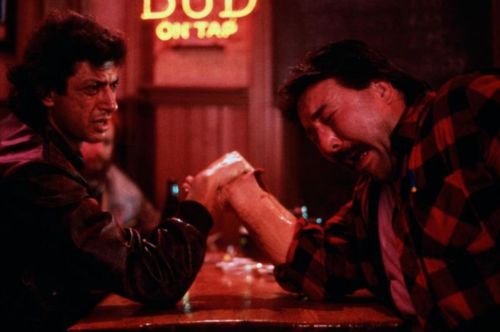
She confronts Brundle, who is starting to look like the world?s most convincing ad for Clearasil. She reveals that she had another scientist friend analyze the hairs she clipped from his back and they appear to be of insect origin. Brundle rejects her theory, accusing her of jealousy and trying to sabotage his work. He kicks her out but soon realizes she may be onto something?when he is able to pull his finger nails off as easily as if they were three-month-old Lee Press-Ons.
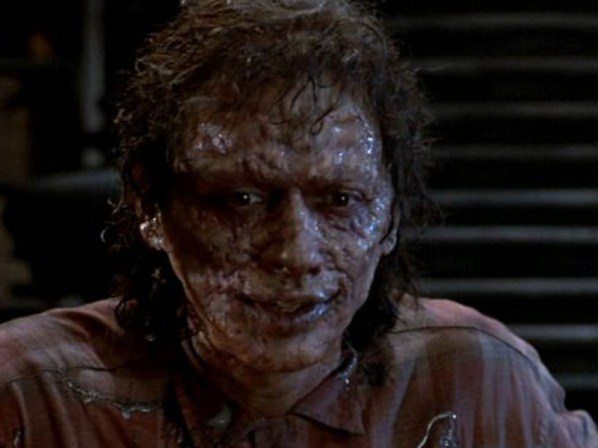
Frantically, he checks the computer?s database and finds that a secondary life form was present in the telepod. The system reveals that the life form was indeed a fly and that it has fused with Brundle.
Things travel downhill fast on a slime-slippery slope as Brundle loses a little more of himself?literally and figuratively?to the physical manifestation of his paranoia. His humanity ebbs away as he devolves more and more into a hideous creature?perhaps the true true self hiding beneath the outer shell.
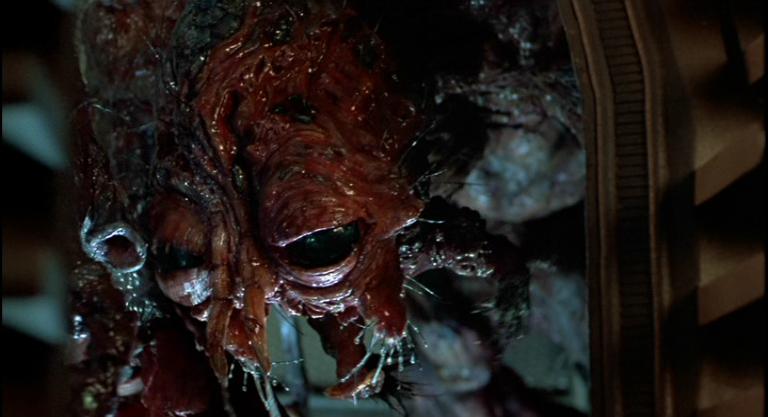
It?s Brundle?s paranoid possessiveness that leads to his downfall. He doesn?t want anyone else to have access to his machine, regardless of how much he urges others to get into the pod. Even if Veronica had made the leap, Brundle would?ve likely been jealous of her ascension to his level of enlightenment.
James 3:16 tells us that ?where jealousy and selfish ambition exist, there will be disorder and every vile practice.? Envy not only hurts the envious. As we see with Brundle, the collateral damage can be devastating.
There is no world for Brundle/Brundlefly apart from the experiment; he is inextricably linked to it even more so after its catastrophic failure. He refuses to trust anyone else; God forbid he trust in a higher power, for how could such an archaic concept hold dominion over one such as he who had conquered so much.
Sound familiar?
This is my money. You can?t have it.
My success is the product of all of my hard work alone.
This is my religion. It is where I feel alive and fulfilled. I think I?ll keep it all to myself.
How often do we forget the others that need our help, the others that need God?s help? How often do we forget the Other, without whom, we can never really achieve?
The Bible warns time and again against idolatry. We are to have nothing that takes the place of God?whether it be a graven image of Baal, the internet, a bank account the size of Texas or a science experiment that will change the world.
Or the face that stares back at us from the mirror.
We are to trust in the Lord with our whole heart and not lean on our own understanding (Proverbs 3:5). And if we follow his teaching, we will not only change ourselves?but the world around us?for the better.
But don?t take my word for it; go read the book.
See what all the buzz is about.


